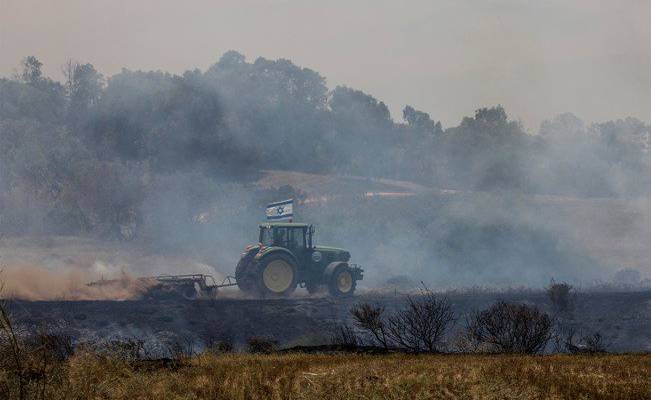“We will not budge from here. We will continue to work the land down to the last meter and we are also optimistic that it will be possible to achieve peace and stability,” an Israel farmer faced with Palestinian terrorism said.
An Israeli farmer displayed defiance in the face of the Palestinian fire kite terrorism emanating from Gaza that has destroyed many acres of farmland and caused severe damage to the environment in the area, telling reporters that “we will not budge from here.”
Danny Rahamim, 64, of Kibbutz Nahal Oz on Thursday briefed journalists from around the world on how Israeli farmers and residents are dealing with the phenomenon that threatens their livelihoods.
Standing amid a blackened, ash-covered hill overlooking the Shuja’iyya neighborhood in Gaza situated a scant two kilometers away, Rahamim, who has been tilling the land for over 40 years, stated, “We will not budge from here. We will continue to work the land down to the last meter and we are also optimistic that it will be possible to achieve peace and stability.”
As he finished his remarks, two firefighters brought a Palestinian kite that had landed nearby and showed how such a primitive, simple and inexpensive device could cause so much damage.
The journalists met Rahamim as part of a tour of the area. The purpose was to balance media coverage of the violence on the Gaza border and increase global awareness of the fire kite phenomenon, which is aimed entirely at civilians.
Over 30 foreign journalists representing German, Spanish, Turkish, Chinese and Japanese press agencies as well as Bloomberg and AP joined the tour. Radio stations and journalists from Switzerland, Bulgaria, Brazil, Russia and South Korea also participated.
The tour began in the burnt, still-smoking fields several hundred meters from Kibbutz Or Haner, where Fire and Rescue Service Spokesperson Yoram Levy briefed the journalists on the new reality. At the service’s regional command center in Sderot, the journalists were briefed on the scope of the challenge in real time.
Col. Nadav Livne, commander of the IDF kite unit, presented the IDF’s perspective, explaining that drones were quickly adapted to enable them to hunt kites. Between 450 and 500 kites have already been intercepted by the high-durability UAVs, which can attain speeds of over 150 kilometers per hour. He said that reservists who specialize in flying UAVs have been mobilized and succeeded in reducing the number of fires over the past week.
‘Life Continues (Almost) as Usual’
Palestinian terrorists have launched more than 600 incendiary kites into Israel since the start of the “March of Return” some 10 weeks ago.
Despite the IDF’s best efforts to stop the kites in flight, more than 200 have managed to set fire to Israeli fields and property. More than 2,000 acres of wood and farmland have been damaged by the flames, ruining produce worth millions of shekels.
Many of the kites are painted with swastikas, revealing the Palestinian rioters’ intentions and their anti-Semitism.
Students at Sderot’s Sapir Academic College, the largest public college in Israel, displayed similar defiance in the face of Palestinian terrorism after they, too, were faced with burning-kite attacks from Gaza. The college is located less than a mile from the Gaza border.
On Tuesday, the fire reached Sapir’s main gate.
“In spite of the ongoing attacks in the last few weeks, we operated (almost) as usual,” the college heads said in a statement.
College classes, exams and conferences continued as scheduled. Last week, including during the attack, Sapir held its prestigious annual “Cinema South” International Film Festival in the neighboring city of Sderot. The students and guests from Israel and abroad packed the screening halls.
“Sapir serves as a cultural, social, economic and educational anchor and inspiration for the whole Western Negev region. Sapir’s resolve and perseverance sustain the resilience of the Israel’s Gaza border communities, the Negev and the State of Israel,” the College said in a statement.
Calls to Shoot Kite Fliers
Due to the lack of a comprehensive solution to this low-tech, inexpensive weapon, there have been increasing calls in Israel to shoot the kite fliers, just like any other terrorist threatening the country.
On Saturday, the IDF identified a group of Palestinians preparing balloons with explosive devices attached to them to be sent into Israel in order to ignite fires and cause extensive damage to Israeli territory.
In response, an IDF aircraft fired a warning shot next to the group. This is the first time IDF has taken such action against the fire kite terrorists.
The IDF “views the use of incendiary balloons and kites with explosive devices attached to them with great severity and will operate to prevent their use.”










